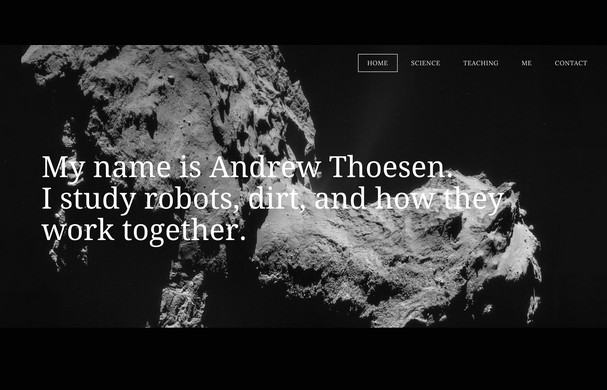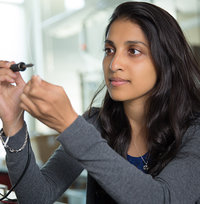
Credit: Andrew Thoesen/andrewthoesen.com
Build-your-own website for scientists
Tips to help you promote your research, attract recruits, and share resources.
11 May 2020

Andrew Thoesen/andrewthoesen.com
For some researchers, self-isolation in the COVID-19 pandemic provides a unique opportunity to build and launch a personal academic website.
It’s a relatively small investment of time that can pay off in terms of career progress, giving researchers greater control over how their expertise is presented online. It can also help researchers to attract PhD students, share resources with the scientific community, and promote their work to the general public.
It's also an important asset for researchers thinking about launching an independent career.
But it can be difficult to know where to start.
Generic developers like Squarespace and Wix provide ready-to-use templates and web analytics tools for a monthly fee. There are also resources aimed specifically at scientists, such as ScienceSites, Owlstown, and Academic Web Pages, which provide support in website design, content development, and maintenance for those with little or no site-building experience.
Before engaging such a service, researchers need to plan the focus of their website. Building it is likely to take 2 to 4 weeks (depending on other demands), and they should also set aside time to update it where necessary, once it’s launched.
For Andrew Thoesen, postdoctoral researcher at the Bio-Inspired Robotics Technology and Healthcare Lab at Arizona State University (whose homepage is seen above) his website has been invaluable.
"Whether communicating my work quickly at conferences through hosted videos, or including it to display my outreach and work for career advancement, it has proven useful from the day I built it," says Thoesen.
"Having the graphical equivalent of a CV at my disposal through my phone – many website builders optimize for mobile viewing now – enhances any elevator pitch I need to make. It also works as a great confidence booster, to [be able to] quickly review your greatest hits."
Nature Index spoke to three researchers who shared their website-making experiences and top tips for how to get started.
Ritu Raman, postdoctoral fellow, chemical engineering
Massachusetts Institute of Technology, Cambridge, Massachusetts Academic website: rituraman.com
My motivation: I started my website in the second year of graduate school. I purchased the domain RituRaman.com, realizing that people in my profession were Googling my name. I figured I could either let them sort through several pages of random links, or give them a well-curated resource. That is when I decided to properly create a website.

L’Oréal USA
Ritu Raman
The challenge: I was intimidated by web design because I’m more of a ‘verbal’ than a ‘visual’ person. After evaluating a few [platform] options, I chose Wordpress, because it’s essentially the same as Microsoft Word, in terms of how you use it to put words and images on a page. I use a standard template and fill it with photos and videos that were professionally taken during my career.
What I do with it: My website has evolved into a dynamic CV. I see it as a one-stop showcase of myself, professionally. Besides using it to highlight my accomplishments in research and teaching, my website also features my outreach activities that focus on advancing women and underrepresented minorities in STEM.
Nearly every week, I get a few emails from young scientists saying how my videos or blogs have helped them navigate something difficult. This makes me feel that spending time on my website is worth it.
Top tip: Be sure to link your social media accounts (Twitter, YouTube, LinkedIn and Instagram) to your website. This is important for search engine page rank optimization (SEO) to increase your visibility.
James Dahlman, assistant professor, biomedical engineering
Georgia Institute of Technology, Atlanta, Georgia Academic website: dahlmanlab.org
My motivation: I set up my website several months before I started my lab at Georgia Tech. I reasoned that the success of my career will depend on recruiting good students. To accomplish that goal, students needed to know that I exist.

Georgia Institute of Technology
James Dahlman
The challenge: The website was challenging to set up, as I wanted a platform that was informative, without creating a cluttered interface. Even now, it still takes a lot of effort to update it with new information, and my students are supporting me with that.
What I do with it: My website has enabled me to recruit excellent students and post-docs. I also have a section named ‘Resources’ for external labs to access computational codes we have created to analyse large datasets. Several labs had been emailing me to access our codes, so I thought it would be easier putting it online to share with the scientific community.
Top tip: A picture tells a thousand words. An effective website interface should contain interesting images to visually educate its visitors.
Sharda Umanath, Assistant Professor, psychological science
Claremont Mckenna College, Claremont, California Academic website: umanathlab.com
My motivation: I wanted to have control over my web presence for folks to find out more about me and my research.

Sharda Umanath
The challenge: I wanted my website to present information in an accessible and professional way, but I had little experience in making one, so I hired ScienceSites to design and maintain my website. The company has a clear sense of what researchers need and they make great suggestions.
What I do with it: Besides showcasing my research, my website acts as a recruitment [tool] for undergraduate research trainees and study participants. Having a polished online presence also helps me recruit community members who might be interested in participating in my research.
I also wanted to give a feeling of legitimacy and excitement to my undergraduate research assistants by showcasing them on my website.
Top tip: If funding permits, seek professional help to upgrade your website and create lasting impressions and impact.
